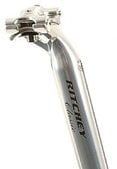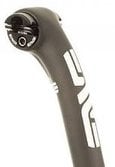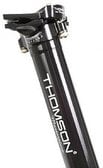Road Bike Seatposts
As the primary support of your body weight, seatposts are a critical component of a comfortable and efficient bike. For the most part, seatposts are utilitarian in nature. For recreational riders, the seatpost that came with your bike will probably last the duration of the bike's life. As long as it allows the saddle to be adjusted to the proper height, and holds it there, your seatpost is doing its job.
 There are two primary seatpost types, and they are distinguished by how they attach to the saddle. Inexpensive department store and children's bikes often employ a one-piece clamping mechanism in which a bolt tightens a clamp around the saddle rails, usually from the sides. These seatposts can be difficult to adjust. Most mid to high-end bikes are equipped with a "micro adjust" seatpost. Micro adjust seatposts utilize a more effective clamp that usually involves one or two bolts which tighten on the saddle above and below the rails.
There are two primary seatpost types, and they are distinguished by how they attach to the saddle. Inexpensive department store and children's bikes often employ a one-piece clamping mechanism in which a bolt tightens a clamp around the saddle rails, usually from the sides. These seatposts can be difficult to adjust. Most mid to high-end bikes are equipped with a "micro adjust" seatpost. Micro adjust seatposts utilize a more effective clamp that usually involves one or two bolts which tighten on the saddle above and below the rails.
If you're a racer or fast recreational rider trying to build a ride that's as light as possible, you've probably realized seatposts can be relatively heavy. A new seatpost can easily save you 100 grams or more, which makes it a popular weight-saving upgrade.
As with all components these days, seatposts are made of carbon or aluminum. Carbon seatposts provide more dampening of road vibration, while aluminum seatposts deliver stiffness and generally cost less. Steel seatposts are fairly common on older bikes, but few after-market steel seatposts are available.
Carbon Seatposts
 The flashiest and highest-end seatposts available are made of carbon fiber. A carbon seatpost will smooth out the ride of an overly stiff frame and probably save a fair amount of weight over most stock seatposts.
The flashiest and highest-end seatposts available are made of carbon fiber. A carbon seatpost will smooth out the ride of an overly stiff frame and probably save a fair amount of weight over most stock seatposts.
Carbon seatposts are not be for everyone. Compact frames often require a large amount of exposed seatpost and have rather sharp seatpost angles. If your frame leaves over eight inches of seatpost exposed, we advise sticking with an aluminum post.
Aluminum Seatpost
 Aluminum seatposts deliver many of the qualities of carbon, including low weight and stiffness, at a lower price. Thomson makes some of the most reliable stems and seatposts on the market.
Aluminum seatposts deliver many of the qualities of carbon, including low weight and stiffness, at a lower price. Thomson makes some of the most reliable stems and seatposts on the market.
Setback
 Seatposts are often made with "setback," in which the post bends a bit backwards. This will accommodate riders who prefer to be positioned farther back on the bike. Setback positions are often utilized by racers as they emphasize the role of the quads and hamstrings in the pedal stroke.
Seatposts are often made with "setback," in which the post bends a bit backwards. This will accommodate riders who prefer to be positioned farther back on the bike. Setback positions are often utilized by racers as they emphasize the role of the quads and hamstrings in the pedal stroke.
Other seatposts, such as those manufactured by Profile Design, have the opposite of setback—they're designed for time-trial and triathlon riders who prefer to be positioned over or in front of their pedals. This allows them to maintain aerodynamic positions and emphasize the muscles most effective when traveling over flatter courses.
It's stuck? Whaddya mean it's stuck?
For some chemical reason, carbon fiber likes aluminum. Aluminum seatposts run the risk of seizing to a carbon frame, and vice versa. When left in contact for a long period of time, carbon and aluminum can bond together, making seatpost adjustment difficult, if not impossible.
One easy way to prevent this is to ride a seatpost that is the same material as your frame. If you are particularly loyal to your Thomson seatpost and carbon frame, however, just make sure you check up on it every couple of months. Applying a smear of grease to the clamped section of seatpost should prevent seizure without compromising the stability of the post.
Carbon bonding with aluminum isn't necessarily common, but it happens. If your carbon bike has been sitting for a couple of years and you can't adjust your seatpost, hope is not lost. You're probably going to have to pull that bottom bracket out and see if you have a hollow seat-tube (Bianchi is a popular brand which often doesn't). If so, make sure the top end of you seatpost is fully sealed (if not, plug up the hole), flip your bike over, get a can of Coke and pour it down the seat-tube and let it sit overnight. Seriously. I don't know much about chemistry, but there is something in carbonated sodas that loosens up seized parts. Just be careful once you get the seatpost to budge that you don't get coke all over the place, and flush it out thoroughly with some sudsy water so you aren't wondering where all those ants are coming from next summer.
Steel seatposts and frames, often found in older bikes and high-end custom bikes, run the risk of corrosion. Corroded steel parts are even more of a problem than a seized aluminum part. If you're experiencing corrosion in a steel frame, take it to a mechanic. Always install steel posts with a touch of grease.
If your post is stuck, but you don't think it's thoroughly seized, flushing it out thoroughly with WD-40 or Tri-Flow and letting it soak in overnight will probably get it to budge.
As with any bike maintenance technique, be very careful. You don't want to crack a frame, or get a piece of cracked seatpost lodged in your aluminum frame. Seized parts are best loosened with patience, technique, and Coca-Cola rather than brute force. When assembling a bike, consider using an anti-seize compound—a specially formulated grease for seize prone parts. Contact us a [email protected] or 1-800-651-4050 for any questions regarding seatpost selection or maintenance.





